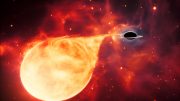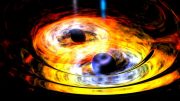
Seen nearly edgewise, the turbulent disk of gas churning around a black hole takes on a crazy double-humped appearance. The black hole’s extreme gravity alters the paths of light coming from different parts of the disk, producing the warped image. The black hole’s extreme gravitational field redirects and distorts light coming from different parts of the disk, but exactly what we see depends on our viewing angle. The greatest distortion occurs when viewing the system nearly edgewise. Credit: NASA’s Goddard Space Flight Center/Jeremy Schnittman
What Is a Black Hole?
Black holes are objects so dense, and with so much mass, that even light cannot escape their gravitational pull.
Black holes exist in different sizes. Stellar black holes, which are around the mass of our Sun, may form when very large stars explode as supernovae at the end of their lives. The star’s core collapses as the outer layers are blown away, leaving a small but extremely dense ball. Supermassive black holes, many millions of times the mass of our Sun, are of more mysterious origin, and are found at the center of galaxies. There are also intermediate-mass black holes (IMBH). These are smaller than the supermassive black holes that lie at the cores of large galaxies, but larger than the stellar-mass black holes formed by the collapse of massive stars. IMBHs are the long-sought “missing link” in black hole evolution and their mere existence is hotly debated, although a few candidates have been found.
Astronomers had no way to test their theories about black holes until Hubble arrived. The telescope’s resolution made it possible to see the effects of the gravitational attraction of some of these objects on their surroundings. Hubble has also proved that supermassive black holes are most likely present at the centers of most, if not all, large galaxies. This has important implications for the theories of galaxy formation and evolution. It is to the study of supermassive black holes that Hubble has made its biggest contribution, and it has also probed the cosmos for the elusive IMBHs. Surprisingly, Hubble has also observed black holes at the hearts of a few small galaxies.
Black holes are objects so dense, and with so much mass, that even light cannot escape their gravitational pull. Credit: ESA/Hubble, EHT collaboration
In 2019 the Event Horizon Telescope collaboration produced the first-ever image of a black hole, lying at the center of the galaxy M87, 55 million light-years away. The image shows a bright ring with a dark center, which is the black hole’s shadow.
Matter falling towards a black hole can also be seen emitting bright light and if the speed of this falling matter can be measured, it is possible to determine the mass of the black hole itself. This is not an easy task and it requires the extraordinary capabilities of Hubble to carry out these sophisticated measurements. Hubble observations have also been fundamental to the study of the jets and discs of matter around a number of black holes.
In 2011, Hubble was used to directly observe the bright disc of matter surrounding a faraway black hole, known as a quasar by using a new technique. In 2020, Hubble found the best evidence to date for an IMBH inside a dense star cluster. In contrast, however, in 2021 it was announced that where scientists were expecting to find an IMBH at the heart of the globular cluster NGC 6397, Hubble instead found evidence of a concentration of smaller black holes lurking there.











Be the first to comment on "Astronomy & Astrophysics 101: Black Hole"